

EvCC researcher: We’re teaching the wrong mathematics. EVERETT — Math is where many college students stumble on their way to a degree.
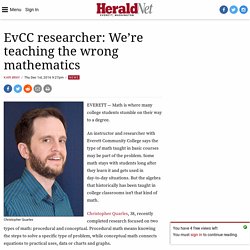
An instructor and researcher with Everett Community College says the type of math taught in basic courses may be part of the problem. Some math stays with students long after they learn it and gets used in day-to-day situations. But the algebra that historically has been taught in college classrooms isn’t that kind of math. Christopher Quarles, 38, recently completed research focused on two types of math: procedural and conceptual. Procedural math means knowing the steps to solve a specific type of problem, while conceptual math connects equations to practical uses, data or charts and graphs.
Quarles worked with former University of California-Berkeley researcher Mickey Davis on an article published Oct. 18 in Community College Review. Activities for College Algebra. Problem solving 101 - Chalkdust. From the outside looking in, maths problem solving can seem like a kind of magic.
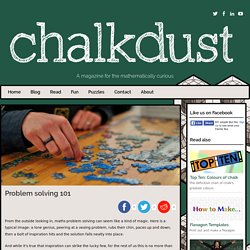
Here is a typical image: a lone genius, peering at a vexing problem, rubs their chin, paces up and down; then a bolt of inspiration hits and the solution falls neatly into place. And while it’s true that inspiration can strike the lucky few, for the rest of us this is no more than an illusion (and often a carefully cultivated illusion at that). In reality, problem solving is usually much more prosaic, nothing more than a careful application of well-known, and often quite elementary, techniques. So what are these elementary techniques? In this article, I’ll look at some of the simplest and easiest to understand. Get some intuition Faced with an unfamiliar problem, it can often be difficult to know where to begin. Puzzle 1. Mathigon Course Library. While the purpose of most sciences is to solve real world problems, pure mathematics is studied for its own sake.

We want to investigate abstract patterns, structures and principles, and prove new results using a consistent logical framework. But of course, even pure mathematics has many real applications. Coming Soon Introduction. A level maths teaching resources. Classroom Cognitive and Metacognitive Strategies for Teachers Revised SR 09.08.10. Response to Intervention. Solving an advanced math problem independently requires the coordination of a number of complex skills.
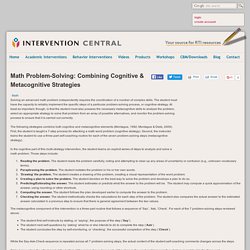
The student must have the capacity to reliably implement the specific steps of a particular problem-solving process, or cognitive strategy. At least as important, though, is that the student must also possess the necessary metacognitive skills to analyze the problem, select an appropriate strategy to solve that problem from an array of possible alternatives, and monitor the problem-solving process to ensure that it is carried out correctly. The following strategies combine both cognitive and metacognitive elements (Montague, 1992; Montague & Dietz, 2009). First, the student is taught a 7-step process for attacking a math word problem (cognitive strategy). Second, the instructor trains the student to use a three-part self-coaching routine for each of the seven problem-solving steps (metacognitive strategy).
Reading the problem. References. Universal Design of College Algebra. Beneficial Practice: Graphic Organizers The benefit of graphic organizers is that they present information in two dimensions.
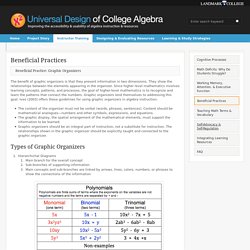
They show the relationships between the elements appearing in the organizer. Since higher level mathematics involves learning concepts, patterns, and processes, the goal of higher-level mathematics is to recognize and learn the patterns that connect the numbers. Graphic organizers lend themselves to addressing this goal. Ives (2003) offers these guidelines for using graphic organizers in algebra instruction: The content of the organizer must not be verbal (words, phrases, sentences).
Flipped Learning: So You Want to Flip Your Math Class? By CUE Member and guest blogger Crystal Kirch This Post Will Focus on Flipping the Math Classroom- Post 3 in Our 6-Part Series.

Metacognative Strategies. Metacognitive Strategies Introduction This site provides a detailed description of metacognitive strategies.
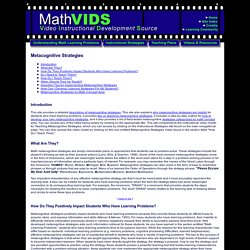
This site also explains why metacognitive strategies are helpful for students who have learning problems, it provides tips on teaching metacognitive strategies, it includes a step-by-step outline for how to develop your own metacognitive strategies, and it also provides a list of field-tested metacognitive strategies categorized by math concept area. You can access any of the listed topics simply by clicking on the appropriate title.
This site complements the instructional video model for Teaching Metacognitive Strategies, which you can access by clicking on the Instructional Strategies site found on the main navigational page. Response to Intervention. Classroom Cognitive and Metacognitive Strategies for Teachers Revised SR 09.08.10. Algebrarules.com: The Most Useful Rules of Basic Algebra, Free & Searchable. Study math for free – Mathplanet. Home - Chalkdust. Home Page. Math, Math and more Math. This section will cover: 1.
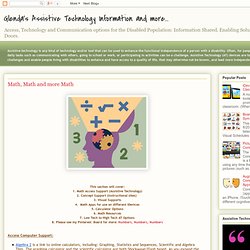
Math Access Support (Assistive Technology) 2. Concept Support (Instructional sites) 3. Visual Supports 4. 5. 6. Access Computer Support: Algebra 2 is a link to online calculators, including: Graphing, Statistics and Sequences, Scientific and Algebra Tiles. V.1issue9. CAPABLE: Calculus Acquisition through Problem and Activity Based Learning. How Student Video Presentations Can Build Community in an Online Course.
It may sound pretty routine to convert a course to an online format, but doing so presents many unexpected challenges and can even challenge a professor’s assumptions about the nature of academic coursework.

Giving a timed test, for instance, is something that’s almost trivial in a face-to-face course but approaches impossibility in an asynchronous online course. How do you give a timed test when you don’t have fixed meeting times? (There are ways to do this, but they are almost all creepy.) You, the professor, simply have to rethink everything. Mereview-16-Apr-2003-4.pdf. Peterson-math. Discovering the Art of Mathematics.
IBL Resources - The Academy of Inquiry Based Learning. PCC math instructors offer a better equation for student learning. Students from California to Maine who enroll in college algebra or precalculus will have Jessica Bernards and Wendy Fresh to thank for both the classroom experience and the passing grade.
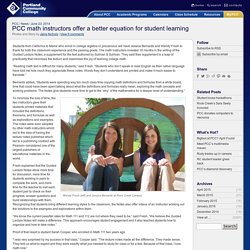
The math instructors invested 18 months in the writing of the Guided Lecture Notes, a supplement for the text authored by Sullivan & Sullivan. 19562_Chapter_1.pdf.